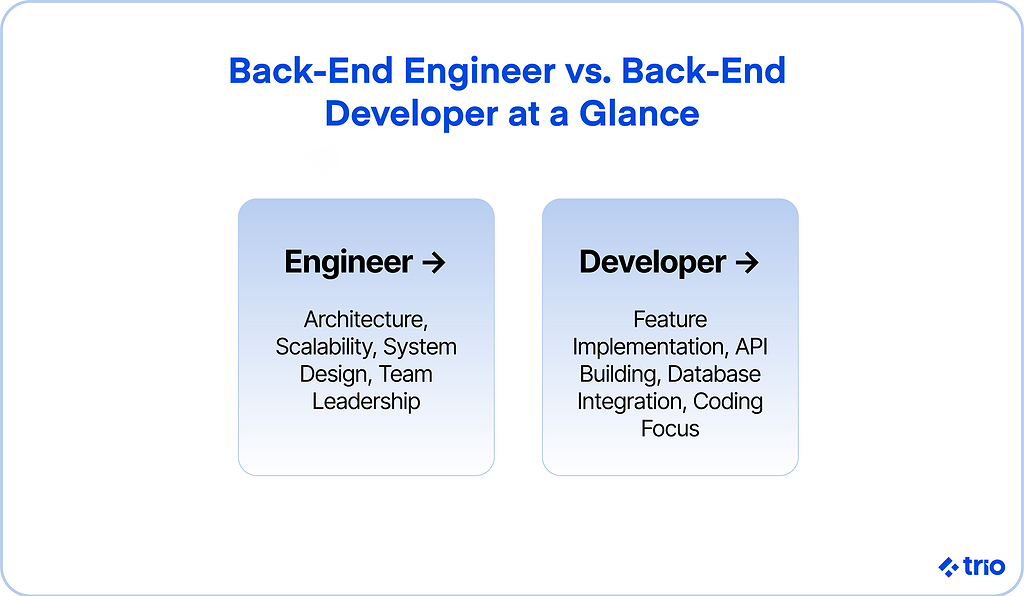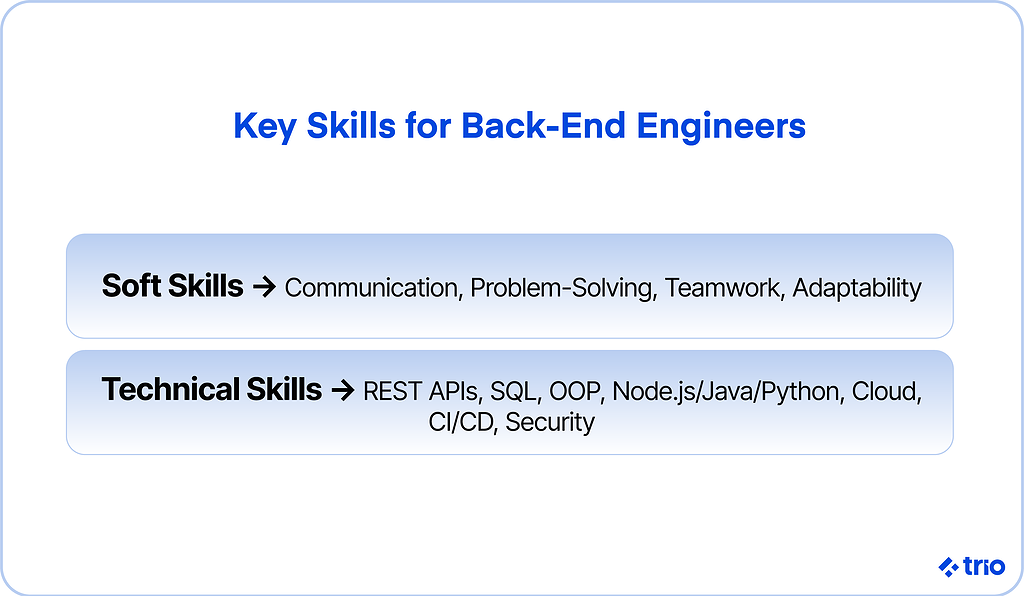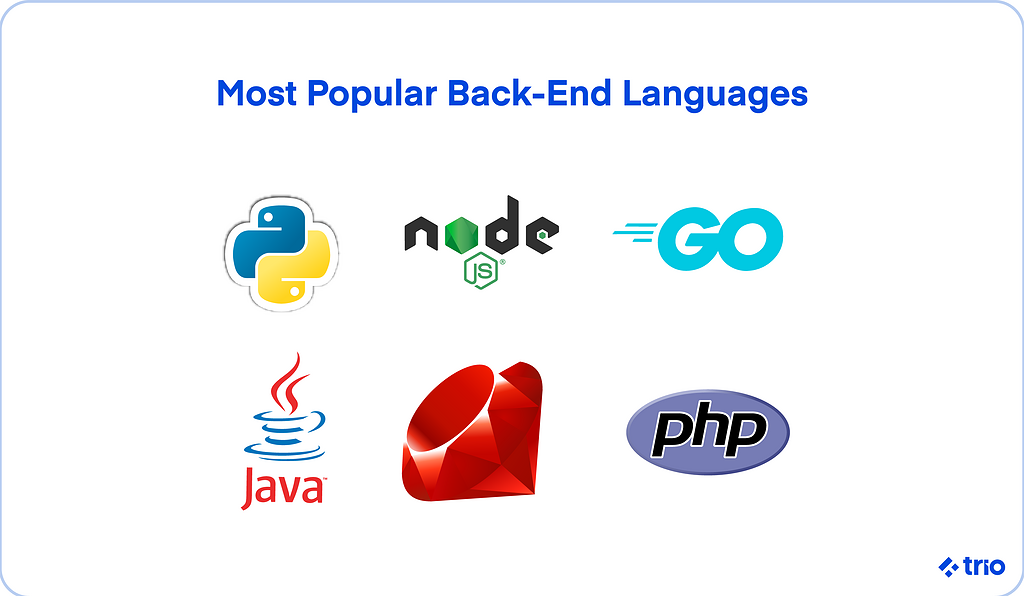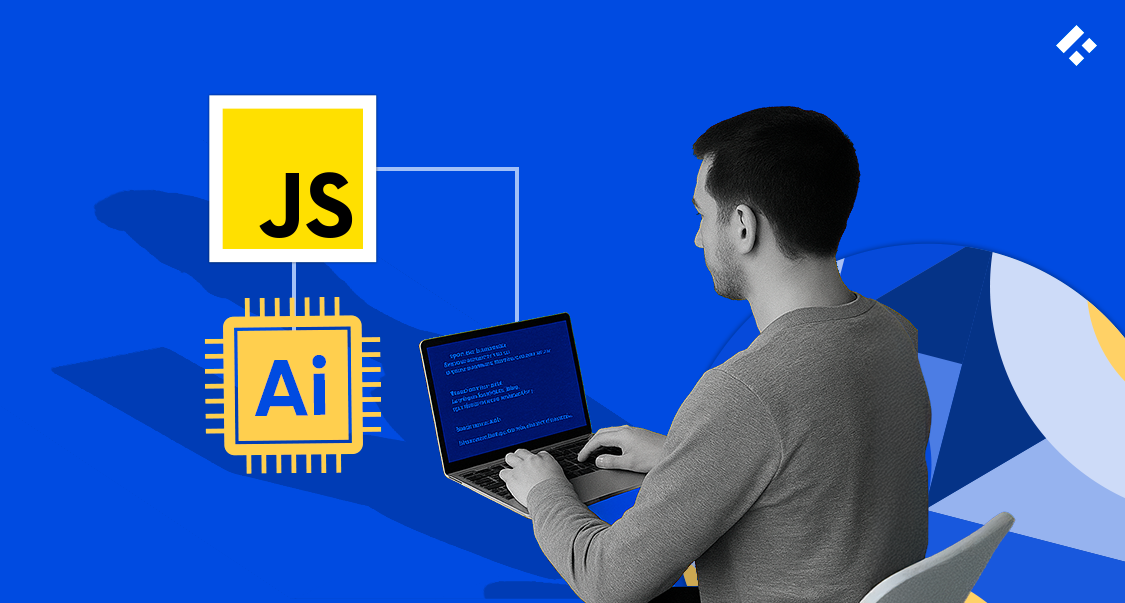Back-end engineers carry much of the heavy weight involved in a software development project, but they don’t always get the credit for the work that they do.
While the front-end of development consists of the graphical element of software, back-end developers ensure that everything going on in the background is running smoothly.
The reality of a back-end engineer’s or back-end developer’s role may not sound as exciting as designing sleek interfaces.
But it is a crucial part of software development. And what back-end engineers and developers do day in and day out is more interesting than you might think.
In fact, many people confuse these two roles and use back-end engineer vs. back-end developer interchangeably. While there is plenty of overlap, there are also key differences that matter if you are looking to hire talent or considering your own career path.
To learn more about what back-end engineers do, keep reading.

To understand how they compare and which role your team might need, keep reading.
Are you ready to start your development project with top-tier talent?
We have the developers you need to take your development project in the right direction. At Trio, we hire only the top 1% of applicants and place them based on your unique requirements. Our custom approach to each project, as well as the quality of our talent, has led to a 97% placement success rate.
Are you ready to start your development project?
We have the developers you need to take your development project in the right direction.
Companies are proven to grow their business faster with Trio.
What Is a Back-End Engineer?
A back-end engineer is a software developer who works on the back-end of development, or the server-side.
In the software industry, development is generally categorized into three categories: front-end development, back-end development, and full-stack development.
In front-end development, also known as client-side development, developers build user interfaces (UIs) and tailor the software’s visual appearance.
However, the server-side is more concerned with the data and internal systems of the software.
This involves managing databases and building application programming interfaces (API), among other things.
Back-end engineers are typically responsible not only for building and maintaining these systems, but also for ensuring they are secure, scalable, and efficient. In many organizations, they play a role in architectural decisions, system design, and long-term technical planning.
In short, a back-end engineer is often considered the “system architect” of server-side development. In contrast, a back-end developer (explained later) may focus more directly on implementing features within that architecture.
What Does a Back-End Engineer Do?
Back-end engineers almost exclusively deal in server components.
Database management, data modeling, server-side scripting, and API governance are a few of a back-end engineer’s primary responsibilities.
Handling the data store remains a vital undertaking in every stage of software development.
Data is information, and whether user inputs or sleuth discoveries, data makes the world go ’round.
Server-side scripts ensure that the software is responding appropriately to user requests.
No matter how aesthetic a UI is, there is business to be done, and back-end engineers make sure that users leave your website or application satisfied.
APIs form liaisons with different software platforms.
For instance, if a customer wants to purchase through your website but prefers to use their PayPal account, Senior Back-end Developers can facilitate this via APIs, of course.
The daily job functions of a back-end engineer may consist of the following:
- Optimizing servers for scalability, speed, and stability
- Implementing security structures and best practices such as authentication, authorization, and data encryption
- Generating reusable code libraries for future implementation
- Generating data storage solutions
- Monitoring and troubleshooting performance issues across distributed systems
- Integrating cloud services (AWS, GCP, Azure) and managing containerized applications (Docker, Kubernetes)
In addition to traditional back-end development responsibilities, the role of back-end engineers includes communicating with project managers, product managers, and other team members, such as front-end engineers.
In modern teams, back-end engineers are also expected to collaborate with DevOps and QA specialists to ensure smooth deployment pipelines and reliable application performance.
What is a Back-End Developer?
A back-end developer is a software professional who works on the server-side of development, much like a back-end engineer. Their main focus is on writing and maintaining the code that powers an application behind the scenes.
Back-end developers are usually responsible for building features, creating APIs, integrating databases, and ensuring that data moves smoothly between the server and the front-end of the software.
While they may not always make high-level architectural decisions, they play a vital role in translating those designs into functional systems.
In practice, back-end developers spend most of their time coding, debugging, and optimizing the parts of the application that users never see directly. They work closely with front-end developers to make sure a reliable and efficient server-side foundation supports the user experience.
In short, back-end developers concentrate on implementing features, while back-end engineers are more often involved in designing and overseeing the larger system architecture.
What Is the Difference Between a Back-End Engineer and a Back-End Developer?
In most cases, back-end engineer and back-end developer are interchangeable titles.
A coder is to a programmer as a programmer is to a developer, and a developer is to an engineer.
The main idea is that if someone is typing away at a computer in a mysterious language that resembles English but not quite, all these titles can apply.
However, in some cases, a back-end engineer is considered a higher position than that of a back-end developer.
You’ll notice that job listings for back-end engineers tend to be higher than similar listings for back-end developers.
These listings make it clear that a back-end engineer carries more responsibilities than their counterpart.
For instance, both a back-end developer and a back-end engineer should be able to write, modify, and debug code, but a back-end engineer will—
- Maintain a relationship with critical stakeholders of the company and the software product.
- Manage the entire software system and understand the complete application architecture.
- Oversee the project and lead a team of other developers.
To make the distinction more straightforward, here’s a side-by-side comparison of the two roles:
| Aspect | Back-End Developer | Back-End Developer |
| Primary Focus | Implementing features and functionality | Designing, building, and overseeing system architecture |
| Responsibilities | Writing and debugging code, integrating databases, building APIs | Managing scalability, security, system performance, and overall architecture |
| Collaboration | Works closely with front-end developers to ensure smooth functionality | Works across teams (front-end, DevOps, product managers, stakeholders) |
| Scope of Work | Narrower. Feature or module level. | Broader. System-wide perspective |
| Leadership | Usually individual contributor | Often leads projects or mentors teams |
| Salary Potential | Solid but slightly lower on average | Typically higher due to expanded responsibilities |
Related reading: Software Developers vs. Software Engineers – What’s the Difference?
What Skills Do Back-End Engineers Need?
Back-end engineers need both soft and technical skills to do their job successfully.
Software development is generally a collaborative process that requires more than what you can find on a resume.
In turn, you want your back-end engineer to be not only skilled but also a good fit for the company culture and the best Back-End engineer possible.
Here are some invaluable soft skills to look out for when hiring a developer or engineer of any kind:
- Excellent communication skills
- Apt time and task management skills
- Quick learning ability and the willingness to learn more
- Deep and broad technical experience
- Problem-solving skills
- A team-oriented mindset
- Adaptability in stressful or uncertain situations
When it comes to technical skills, you’ll mostly get a chance to test your candidate’s ability during the technical interview and coding challenge.
These are the skills you will want to pinpoint in your potential hire:
- Demonstrated experience developing REST APIs
- Familiarity with SQL/relational databases and writing performant queries
- Proficiency in building robust APIs
- Mastery of object-oriented programming strategies
- Ability to build highly available, fault-tolerant, scalable, and distributed systems
- Expert working knowledge of back-end programming languages and tools such as Java, Ruby on Rails, Node.js, etc.
- Experience with cloud platforms (AWS, GCP, or Azure) and serverless architectures
- Familiarity with containerization and orchestration tools like Docker and Kubernetes
- Knowledge of CI/CD pipelines and version control (e.g., Git, GitHub, GitLab)
- Understanding of security best practices, authentication/authorization frameworks, and compliance requirements (e.g., GDPR, SOC 2)

The 4 Most Common Languages for Back-End Development
Back-end engineering requires a unique set of tools to accomplish its goals. To put it one way, some programming languages are better equipped than others.
While dozens of languages can be used on the server side, a few have become especially common thanks to their maturity, community support, and performance.

1. PHP
The vast majority of small and large-scale websites integrate PHP as their back-end.
In more traditional website use cases, PHP is typically used to fetch user information and securely store it. It is often the foundation of login and registration processes.
2. Python
Many emerging tech companies use Python web frameworks such as Django and Flask to power high-performing web apps.
Python is a general-purpose language with high popularity ratings amongst developer communities, primarily because of its ease of use. Nowadays, a Senior Python developer is a highly coveted professional.
Python is also widely used for data science and AI/ML applications, making it versatile beyond web development.
Here at Trio, you will find more content about Python.
3. Ruby
Among its fans, Ruby is considered to be just as intuitive as Python. Its most popular framework is Ruby on Rails.
For most developers, it’s hard to get through a conversation about web development without Ruby on Rails being mentioned at least once.
4. Java
As a multipurpose programming language, Java has become a staple language in developing and employing cross-platform desktop, web, and Android applications.
A lightweight Java-based framework called Spring has gained the most recognition in the Java community. For more information, Trio’s best and senior Java developers are here to help.
5. Node.js
Node.js allows developers to use JavaScript on the server side, making it one of the most popular back-end technologies today.
Its non-blocking, event-driven architecture is ideal for building scalable, high-performance applications such as streaming services, chat apps, and real-time dashboards.
6. Go (Golang)
Go, developed by Google, is known for its simplicity, concurrency support, and efficiency.
It’s increasingly used for cloud-native applications, microservices, and distributed systems where speed and scalability are critical.
Salary Comparisons: Back-end Engineer vs. Developer
Both back-end engineers and back-end developers earn substantial salaries.
However, engineers often have higher pay due to their broader responsibilities.
According to Glassdoor, the average salary of a back-end engineer in the US is roughly $172,507 per year, while back-end developers earn approximately $115,633 per year.
Big companies like Apple and Samsung generally pay their back-end engineers higher salaries.
Regions such as Latin America and Eastern Europe offer lower back-end engineering costs due to economic differences.
How To Hire a Back-End Engineer
The process of hiring a back-end engineer is not a simple one. You need to have a relatively firm understanding of the role to be able to choose the right candidate.
From afar, the essential steps of a hiring process may look simply like posting a job description on Indeed and moving on from there.
In reality, the before, during, and after of the process is a bit more complicated.
To post a job listing, you need to know the details of your project and which duties your back-end developer or back-end engineer will be responsible for.
You also need to know where to find software developers and engineers in the wide range of job networks that exist.
Frankly, most software professionals are taken, so to speak, and they don’t browse Glassdoor or ZipRecruiter regularly. You may even need to do recruitment outreach on social platforms like Reddit or LinkedIn.
Make sure to weigh the costs of doing all this as well. On average, it takes over a month to find new hires, and several thousand dollars can be lost during the process.
Once you identify individuals with potential, you will need to narrow down your candidates through a series of intensive interviews, including both technical and traditional assessments, software development challenges, and thorough screening and vetting procedures.
Given this exhaustive workload, some companies choose to outsource the hiring process and overall development to outside agencies. This can be a low-budget solution for those who really need it.
Back-End Engineer Job Description Template
Your job description for hiring back-end engineers should be inviting but informational.
You will need to be descriptive, yet concise, and tell the reader exactly what you’re looking for.
The job description should consist of four main sections:
1. Company Background: Explain what your business does and the mission or purpose behind your work.
2. About the Job: Briefly describe what the job is and what service you’re looking for.
3. Roles & Responsibilities: Use a bullet point list to outline the day-to-day duties the candidate should expect to fulfill if hired.
4. Qualifications & Skills: List the must-have qualifications and skills that you want to have in an optimal candidate.
Check out Trio’s article on writing a back-end developer job description for more insight on how a detailed job listing should look.

Elevate Your Team with Trio AI Talent
Empower Your Projects with Trio’s Elite Tech Teams
Conclusion
Now that you have a good idea of what a back-end engineer is, you probably figure it’d be a good idea to have one on your team.
Well, you’re on the right track. Back-end engineers are a crucial component of any software development team.
And if you’re trying to build a software product of any kind, you need back-end engineers front and center to get things moving.
You already know that hiring back-end engineers on your own can be a daunting task. But there are other options.
Learn more about hiring a back-end engineer! Or reach out to get in touch!






